new posts in all blogs
Viewing: Blog Posts Tagged with: funny poetry, Most Recent at Top [Help]
Results 1 - 8 of 8
How to use this Page
You are viewing the most recent posts tagged with the words: funny poetry in the JacketFlap blog reader. What is a tag? Think of a tag as a keyword or category label. Tags can both help you find posts on JacketFlap.com as well as provide an easy way for you to "remember" and classify posts for later recall. Try adding a tag yourself by clicking "Add a tag" below a post's header. Scroll down through the list of Recent Posts in the left column and click on a post title that sounds interesting. You can view all posts from a specific blog by clicking the Blog name in the right column, or you can click a 'More Posts from this Blog' link in any individual post.
 Fun Fact: The American Library Association does not currently give an award specifically to great works of children’s book poetry. Is not that strange? When I first discovered this to be true, I was perplexed. I’ve always been a bit of a rube when it comes to the poetic form. Placing stresses on syllables and knowing what constitutes a sestina and all that. Of course even without its own award specifically, poetry can win the Newbery or the Caldecott. Yet too often when it happens it’s in the form of a verse novel or its sort of pooh-poohed for its win. Remember when Last Stop on Market Street won the Newbery and folks were arguing that it was the first picture book to do so since A Visit to William’s Blake’s Inn couldn’t possibly be considered a picture book because it was poetry? None of this is to say that poetry doesn’t win Newberys (as recently as 2011 Dark Emperor and Other Poems of the Night by Joyce Sidman won an Honor) but aside from the month of April (Poetry Month a.k.a. the only time the 811 section of the public library is sucked dry) poetry doesn’t get a lot of attention.
Fun Fact: The American Library Association does not currently give an award specifically to great works of children’s book poetry. Is not that strange? When I first discovered this to be true, I was perplexed. I’ve always been a bit of a rube when it comes to the poetic form. Placing stresses on syllables and knowing what constitutes a sestina and all that. Of course even without its own award specifically, poetry can win the Newbery or the Caldecott. Yet too often when it happens it’s in the form of a verse novel or its sort of pooh-poohed for its win. Remember when Last Stop on Market Street won the Newbery and folks were arguing that it was the first picture book to do so since A Visit to William’s Blake’s Inn couldn’t possibly be considered a picture book because it was poetry? None of this is to say that poetry doesn’t win Newberys (as recently as 2011 Dark Emperor and Other Poems of the Night by Joyce Sidman won an Honor) but aside from the month of April (Poetry Month a.k.a. the only time the 811 section of the public library is sucked dry) poetry doesn’t get a lot of attention.
So rather than relegate all poetry discussions to April, let us today celebrate some of the lovelier works of poetry out for kids this year. Because we lucked out, folks. 2016 was a great year for verse:
2016 Poetry Books for Kids
Are You an Echo?: The Lost Poetry of Misuzu Kaneko by David Jacobson, ill. Toshikado Hajiri, translations by Sally Ito and Michiko Tsuboi
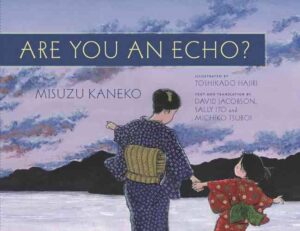
No surprises here. If you know me then you know I’m gaga for this title. For the purposes of today’s list, however, let’s just zero in on Kaneko’s own poetry. Cynical beast that I am, I would sooner eat my own tongue than use a tired phrase like “childlike wonder” to describe something. And yet . . . I’m stuck. Honestly there’s no other way to adequately convey to you what Kaneko has done so perfectly with this book. Come for the biography and history lesson. Stay for the incomparable poems.
Freedom Over Me: Eleven Slaves, Their Lives and Dreams Brought to Life by Ashley Bryan

I’m not entirely certain that I can express in words how deeply satisfying it’s been to see this book get as much love and attention as it has, so far. Already its appeared on Chicago Public Library’s Best of the Best, its been a Kirkus Prize Finalist, it was on the NCTE Notable Poetry List, and New York Public Library listed it on their Best Books for Kids. I would have liked to add an Image Award nomination in there as well, but you don’t always get what you want. Regardless, I maintain my position that this is a serious Newbery contender. Even if it misses out during the January award season, there is comfort in knowing that folks are finding it. Very satisfying.
Grumbles From the Town: Mother-Goose Voices With a Twist by Jane Yolen and Rebecca Kai Dotlich, ill. Angela Matteson

Its been promoted as a writing prompt book, but I’d argue that the poetry in this collection stands on its own two feet as well. Yolen and Dotlich take classic nursery rhymes and twist them. We’ve all seen that kind of thing before, but I like how they’ve twisted them. A passing familiarity with the original poetry a good idea, though they’ve covered their bases and included that information in the back of the book as well. Good original fun all around.
Jazz Day: The Making of a Famous Photograph by Roxane Orgill, ill. Francis Vallejo

So far it’s won the only major award (aside from the Kirkus prize) to be released so far for a 2016 title. Jazz Day took home the gold when it won in the picture book category of the Boston Globe-Horn Book Awards. And, granted, I was on that committee, but I wasn’t the only one there. It’s such an amazing book, and aside from poetry its hard to slot it into any one category. Fiction or nonfiction? You be the judge.
Miss Muffet, Or What Came After by Marilyn Singer, ill. David Litchfield

It’s sort of epic. From one single short little nursery rhyme, Singer spins out this grandiose tale of crushed hopes, impossible dreams, and overcoming arachnophobia. Since it’s a story told in rhyme I’m sort of cheating, putting it on this poetry list. Maybe it’s more school play than poetry book. I say, why not be both?
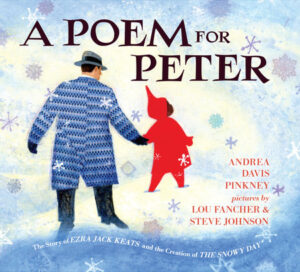
Now this book has been nominated for an NAACP Image Award, so there is some justice in this world. When I first read the description I wasn’t entirely certain how it would work. Imagine the daunting task of telling Ezra Jack Keats’ story using his own illustration style. Imagine too the difficulty that comes with using poetry and verse to tell the details of his story. Pinkney’s done poetry of one sort or another before, but I dare say this is her strongest work to date in that style.
Slickety Quick: Poems About Sharks by Skila Brown, ill. Bob Kolar
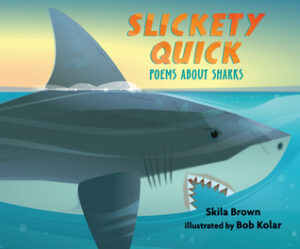
From the start I liked the poems (they were smart) but since it was about real sharks I pondered that question every children’s librarian knows so well: how would it fly with kids? Well, I donated a copy to my kid’s daycare and found, to my infinite delight, that the kids in that class were CRAZY about it. Every day when I went to pick my daughter up, she and the other kids would start telling me shark facts. You’ve gotta understand that these were four-year-olds telling me this stuff. If they get such a kick out of the book (and they do) imagine how the older kids might feel!
A Toucan Can, Can You? by Danny Adlerman, ill. Various
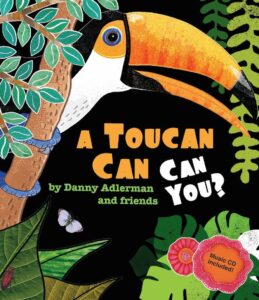
It’s baaaaack. Yeah, this little self-published gem keeps cropping up on my lists. Someone recently asked me where they could purchase it, since it’s not available through the usual streams. I think you can get it here, in case you’re curious. And why should you be curious? Because it takes that old How Much Wood Could a Woodchuck Chuck, expands it, and then gets seriously great illustrators to contribute. A lovely book.
Somo Como Las Nubes / We Are Like the Clouds by Jorge Argueta, ill. Elisa Amado
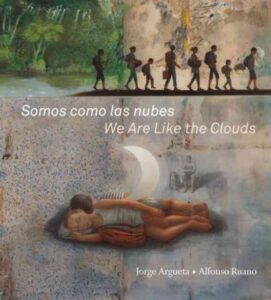
Because to be perfectly frank, your shelves aren’t exactly exploding with books about refugee children from South America. That said, it’s easy to include books on lists of this sort because their intentions are good. It’s another thing entirely when the book itself actually is good. Argueta is an old hand at this. You can trust him to do a fantastic job, and this book is simultaneously necessary and expertly done. There’s a reason I put it on my bilingual book list as well.
Spinach Dip Pancakes by Kevin Kammeraad, ill. Danny Adlerman, Kim Adlerman, Chris Fox, Alynn Guerra, Justin Haveman, Ryan Hipp, Stephanie Kammeraad, Carlos Kammeraad, Maria Kammeraad, Steve Kammeraad, Linda Kammeraad, Laurie Keller, Scott Mack, Ruth McNally Barshaw, Carolyn Stich, Joel Tanis, Corey Van Duinen, Aaron Zenz, & Rachel Zylstra
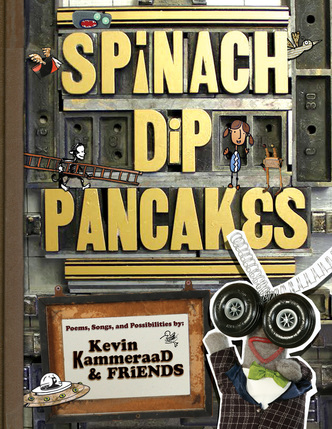
This book bears not a small number of similarities to the aforementioned Toucan Can book. The difference, however, is that these are all original little tiny poems put into a book illustrated by a huge range of different illustrators. The poems are funny and original and the art eclectic, weird, wise and wonderful. It even comes with a CD of performances of the poems. Want a taste? Then I am happy to premiere a video that is accompanying this book. The video cleverly brings to life the poem “Game”. I think you’ll get a kick out of it. And then be unable to remove it from your brain (good earworm, this).
If you liked that, check out the book’s book trailer and behind-the-scenes peek as well.
Wet Cement: A Mix of Concrete Poems by Bob Raczka
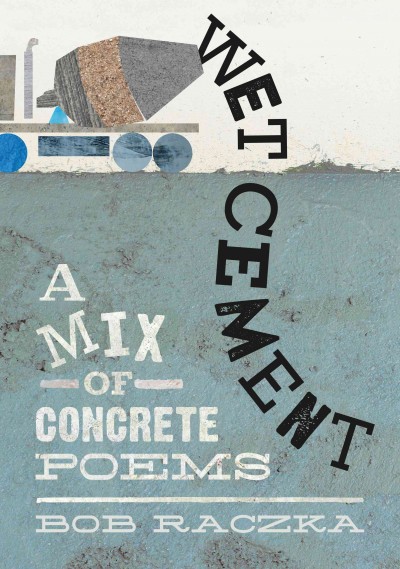
My year is not complete unless I am able to work a Raczka poetry collection onto a list. I’m very partial to this one. It’s a bit graphic design-y and a bit clever as all get out. Here’s my favorite poem of the lot:
Poetry is about taking away the words you don’t need
poetry is taking away words you don’t need
poetry is words you need
poetry is words
try
When Green Becomes Tomatoes: Poems for All Seasons by Julie Fogliano, ill. Julie Morstad

I think I broke more than a few hearts when I told people that Morstad’s Canadian status meant the book was ineligible for a Caldecott. At least you can take comfort in the fact that the poetry is sublime. I think we’ve all seen our fair share of seasonal poems. They’re not an original idea, yet Fogliano makes them seem new. This collection actually bears much in common with the poetry of the aforementioned Misuzu Kaneko. I think she would have liked it.
You Can Fly: The Tuskegee Airmen by Carole Boston Weatherford, ill. Jeffery Boston Weatherford
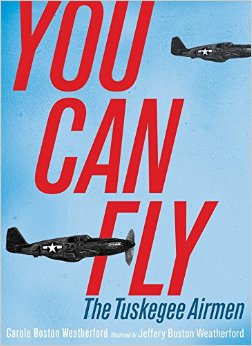
It’s poetry and a kind of verse novel as well. I figured I should include one in today’s list, though I’d argue that the verse here serves the poems better than the storyline. There is a storyline, of course, but I like the poetry for its own sake. My favorite in the book? The one about Lena Horne. I had no idea the personal sacrifices she made during WWII. There’s a picture book bio coming out about her in 2017, by the way. Looks like I’ll need to know more.
Interested in the other lists of the month? Here’s the schedule so that you can keep checking back:
December 1 – Board Books
December 2 – Board Book Adaptations
December 3 – Nursery Rhymes
December 4 – Picture Book Readalouds
December 5 – Rhyming Picture Books
December 6 – Alphabet Books
December 7 – Funny Picture Books
December 8 – Calde-Nots
December 9 – Picture Book Reprints
December 10 – Math Picture Books
December 11 – Bilingual Books
December 12 – International Imports
December 13 – Books with a Message
December 14 – Fabulous Photography
December 15 – Fairy Tales / Folktales
December 16 – Oddest Books of the Year
December 17 – Older Picture Books
December 18 – Easy Books
December 19 – Early Chapter Books
December 20 – Graphic Novels
December 21 – Poetry
December 22 – Fictionalized Nonfiction
December 23 – American History
December 24 – Science & Nature Books
December 25 – Transcendent Holiday Titles
December 26 – Unique Biographies
December 27 – Nonfiction Picture Books
December 28 – Nonfiction Chapter Books
December 29 – Novel Reprints
December 30 – Novels
December 31 – Picture Books


By:
Betsy Bird,
on 10/5/2016
Blog:
A Fuse #8 Production
(
Login to Add to MyJacketFlap)
JacketFlap tags:
Misuzu Kaneko,
Best Books of 2016,
2016 reviews,
Reviews 2016,
2016 poetry,
2016 picture book biographies,
David Jacobson,
Michiko Tsuboi,
Toshikado Hajiri,
Reviews,
poetry,
Best Books,
picture book biographies,
Sally Ito,
funny poetry,
middle grade poetry,
Add a tag
 Are You an Echo? The Lost Poetry of Misuzu Kaneko
Are You an Echo? The Lost Poetry of Misuzu Kaneko
Narrative and Translation by David Jacobson, Sally Ito, and Michiko Tsuboi
Illustrated by Toshikado Hajiri
Chin Music Press
$19.50
ISBN: 9781634059626
Ages 5 and up
On shelves now
Recently I was at a conference celebrating the creators of different kinds of children’s books. During one of the panel discussions an author of a picture book biography of Fannie Lou Hamer said that part of the mission of children’s book authors is to break down “the canonical boundaries of biography”. I knew what she meant. A cursory glance at any school library or public library’s children’s room will show that most biographies go to pretty familiar names. It’s easy to forget how much we need biographies of interesting, obscure people who have done great things. Fortunately, at this conference, I had an ace up my sleeve. I knew perfectly well that one such book has just been published here in the States and it’s a game changer. Are You an Echo? The Lost Poetry of Misuzu Kaneko isn’t your typical dry as dust retelling of a life. It crackles with energy, mystery, tragedy, and, ultimately, redemption. This book doesn’t just break down the boundaries of biography. It breaks down the boundaries placed on children’s poetry, art, and translation too. Smarter and more beautiful than it has any right to be, this book challenges a variety of different biography/poetry conventions. The fact that it’s fun to read as well is just gravy.
Part biography, part poetry collection, and part history, Are You an Echo? introduces readers to the life and work of celebrated Japanese poet Misuzu Kaneko. One day a man by the name of Setsuo Yazaki stumbled upon a poem called “Big Catch”. The poet’s seemingly effortless ability to empathize with the plight of fish inspired him to look into her other works. The problem? The only known book of her poems out there was caught in the conflagration following the firebombing of Tokyo during World War II. Still, Setsuo was determined and after sixteen years he located the poet’s younger brother who had her diaries, containing 512 of Misuzu’s poems. From this, Setsuo was able to piece together her life. Born in 1902, Misuzu Kaneko grew up in Senzaki in western Japan. She stayed in school at her mother’s insistence and worked in her mother’s bookstore. For fun she submitted some of her poems to a monthly magazine and shockingly every magazine she submitted them to accepted them. Yet all was not well for Misuzu. She had married poorly, contracted a disease from her unfaithful husband that caused her pain, and he had forced her to stop writing as well. Worst of all, when she threatened to leave he told her that their daughter’s custody would fall to him. Unable to see a way out of her problem, she ended her life at twenty-six, leaving her child in the care of her mother. Years passed, and the tsunami of 2011 took place. Misuzu’s poem “Are You an Echo?” was aired alongside public service announcements and it touched millions of people. Suddenly, Misuzu was the most famous children’s poet of Japan, giving people hope when they needed it. She will never be forgotten again. The book is spotted with ten poems throughout Misuzu’s story, and fifteen additional poems at the end.
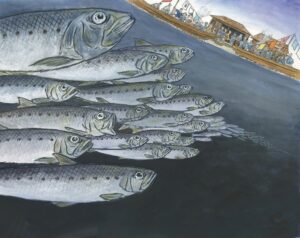 There’s been a lot of talk in the children’s literature sphere about the role of picture book biographies. More specifically, what’s their purpose? Are they there simply to inform and delight or do they need to actually attempt to encapsulate the great moments in a person’s life, warts and all? If a picture book bio only selects a single moment out of someone’s life as a kind of example, can you still call it a biography? If you make up dialogue and imagine what might have happened in one scene or another, do those fictional elements keep it from the “Biography” section of your library or bookstore, or is there a place out there for fictionalized bios? These questions are new ones, just as the very existence of picture book biographies, in as great a quantity as we’re seeing them, is also new. One of the takeaways I’ve gotten from these conversations is that it is possible to tackle difficult subjects in a picture book bio, but it must be done naturally and for a good reason. So a story like Gary Golio’s Spirit Seeker can discuss John Coltrane’s drug abuse, as long as it serves the story and the character’s growth. On the flip side, Javaka Steptoe’s Radiant Child, a biography of Basquiat, makes the choice of discussing the artist’s mother’s fight with depression and mental illness, but eschews any mention of his own suicide.
There’s been a lot of talk in the children’s literature sphere about the role of picture book biographies. More specifically, what’s their purpose? Are they there simply to inform and delight or do they need to actually attempt to encapsulate the great moments in a person’s life, warts and all? If a picture book bio only selects a single moment out of someone’s life as a kind of example, can you still call it a biography? If you make up dialogue and imagine what might have happened in one scene or another, do those fictional elements keep it from the “Biography” section of your library or bookstore, or is there a place out there for fictionalized bios? These questions are new ones, just as the very existence of picture book biographies, in as great a quantity as we’re seeing them, is also new. One of the takeaways I’ve gotten from these conversations is that it is possible to tackle difficult subjects in a picture book bio, but it must be done naturally and for a good reason. So a story like Gary Golio’s Spirit Seeker can discuss John Coltrane’s drug abuse, as long as it serves the story and the character’s growth. On the flip side, Javaka Steptoe’s Radiant Child, a biography of Basquiat, makes the choice of discussing the artist’s mother’s fight with depression and mental illness, but eschews any mention of his own suicide.
Are You An Echo? is an interesting book to mention alongside these two other biographies because the story is partly about Misuzu Kaneko’s life, partly about how she was discovered as a poet, and partly a highlight of her poetry. But what author David Jacobson has opted to do here is tell the full story of her life. As such, this is one of the rare picture book bios I’ve seen to talk about suicide, and probably the only book of its kind I’ve ever seen to make even a passing reference to STDs. Both issues informed Kaneko’s life, depression, feelings of helplessness, and they contribute to her story. The STD is presented obliquely so that parents can choose or not choose to explain it to kids if they like. The suicide is less avoidable, so it’s told in a matter-of-fact manner that I really appreciated. Euphemisms, for the most part, are avoided. The text reads, “She was weak from illness and determined not to let her husband take their child. So she decided to end her life. She was only twenty-six years old.” That’s bleak but it tells you what you need to know and is honest to its subject.
 But let’s just back up a second and acknowledge that this isn’t actually a picture book biography in the strictest sense of the term. Truthfully, this book is rife, RIFE, with poetry. As it turns out, it was the editorial decision to couple moments in Misuzu’s life with pertinent poems that gave the book its original feel. I’ve been wracking my brain, trying to come up with a picture book biography of a poet that has done anything similar. I know one must exist out there, but I was hard pressed to think of it. Maybe it’s done so rarely because the publishers are afraid of where the book might end up. Do you catalog this book as poetry or as biography? Heck, you could catalog it in the Japanese history section and still be right on in your assessment. It’s possible that a book that melds so many genres together could only have been published in the 21st century, when the influx of graphic inspired children’s literature has promulgated. Whatever the case, reading this book you’re struck with the strong conviction that the book is as good as it is precisely because of this melding of genres. To give up this aspect of the book would be to weaken it.
But let’s just back up a second and acknowledge that this isn’t actually a picture book biography in the strictest sense of the term. Truthfully, this book is rife, RIFE, with poetry. As it turns out, it was the editorial decision to couple moments in Misuzu’s life with pertinent poems that gave the book its original feel. I’ve been wracking my brain, trying to come up with a picture book biography of a poet that has done anything similar. I know one must exist out there, but I was hard pressed to think of it. Maybe it’s done so rarely because the publishers are afraid of where the book might end up. Do you catalog this book as poetry or as biography? Heck, you could catalog it in the Japanese history section and still be right on in your assessment. It’s possible that a book that melds so many genres together could only have been published in the 21st century, when the influx of graphic inspired children’s literature has promulgated. Whatever the case, reading this book you’re struck with the strong conviction that the book is as good as it is precisely because of this melding of genres. To give up this aspect of the book would be to weaken it.
Right off the bat I was impressed by the choice of poems. The first one you encounter is called “Big Catch” and it tells about a village that has caught a great number of fish. The poem ends by saying, “On the beach, it’s like a festival / but in the sea they will hold funerals / for the tens of thousands dead.” The researcher Setsuo Yazaki was impressed by the poet’s empathy for the fish, and that empathy is repeated again and again in her poems. “Big Catch” is actually one of her bleaker works. Generally speaking, the poems look at the world through childlike eyes. “Wonder” contemplates small mysteries, in “Beautiful Town” the subject realizes that a memory isn’t from life but from a picture in a borrowed book, and “Snow Pile” contemplates how the snow on the bottom, the snow on the top, and the snow in the middle of a pile must feel when they’re all pressed together. The temptation would be to call Kaneko the Japanese Emily Dickenson, owing to the nature of the discovery of her poems posthumously, but that’s unfair to both Kaneko and Dickenson. Kenko’s poems are remarkable not just because of their original empathy, but also because they are singularly childlike. A kid would get a kick out of reading these poems. That’s no mean feat.
 Mind you, we’re dealing with a translation here. And considering how beautifully these poems read, you might want a note from the translators talking about their process. You can imagine, then, how thrilled I was to find a half-page’s worth of a “Translators’ Note” explaining aspects of the work here that never would have occurred to me in a million years. The most interesting problem came down to culture. As Sally Ito and Michiko Tsuboi write, “In Japanese, girls have a particular way of speaking that is affectionate and endearing . . . However, English is limited in its capacity to convey Misuzu’s subtle feminine sensibility and the elegant nuances of her classical allusions. We therefore had to skillfully work our way through both languages, often producing several versions of a poem by discussing them on Skype and through extensive emails – Michiko from Japan, Sally from China – to arrive at the best possible translations in English.” It makes a reader really sit back and admire the sheer levels of dedication and hard work that go into a book of this sort. If you read this book and find that the poems strike you as singularly interesting and unique, you may now have to credit these dedicated translators as greatly as you do the original subject herself. We owe them a lot.
Mind you, we’re dealing with a translation here. And considering how beautifully these poems read, you might want a note from the translators talking about their process. You can imagine, then, how thrilled I was to find a half-page’s worth of a “Translators’ Note” explaining aspects of the work here that never would have occurred to me in a million years. The most interesting problem came down to culture. As Sally Ito and Michiko Tsuboi write, “In Japanese, girls have a particular way of speaking that is affectionate and endearing . . . However, English is limited in its capacity to convey Misuzu’s subtle feminine sensibility and the elegant nuances of her classical allusions. We therefore had to skillfully work our way through both languages, often producing several versions of a poem by discussing them on Skype and through extensive emails – Michiko from Japan, Sally from China – to arrive at the best possible translations in English.” It makes a reader really sit back and admire the sheer levels of dedication and hard work that go into a book of this sort. If you read this book and find that the poems strike you as singularly interesting and unique, you may now have to credit these dedicated translators as greatly as you do the original subject herself. We owe them a lot.
In the back of the book there is a note from the translators and a note from David Jacobson who wrote the text of the book that didn’t include the poetry. What’s conspicuously missing here is a note from the illustrator. That’s a real pity too since biographical information about artist Toshikado Hajiri is missing. Turns out, Toshikado is originally from Kyoto and now lives in Anan, Tokushima. Just a cursory glance at his art shows a mild manga influence. You can see it in the eyes of the characters and the ways in which Toshikado chooses to draw emotions. That said, this artist is capable of also conveying great and powerful moments of beauty in nature. The sunrise behind a beloved island, the crush of chaos following the tsunami, and a peach/coral/red sunset, with a grandmother and granddaughter silhouetted against its beauty. What Toshikado does here is match Misuzu’s poetry, note for note. The joyous moments she found in the world are conveyed visually, matching, if never exceeding or distracting from, her prowess. The end result is more moving than you might expect, particularly when he includes little human moments like Misuzu reading to her daughter on her lap or bathing her one last time.
Here is what I hope happens. I hope that someday soon, the name “Misuzu Kaneko” will become better known in the United States. I hope that we’ll start seeing collections of her poems here, illustrated by some of our top picture book artists. I hope that the fame that came to Kaneko after the 2011 tsunami will take place in America, without the aid of a national disaster. And I hope that every child that reads, or is read, one of her poems feels that little sense of empathy she conveyed so effortlessly in her life. I hope all of this, and I hope that people find this book. In many ways, this book is an example of what children’s poetry should strive to be. It tells the truth, but not the truth of adults attempting to impart wisdom upon their offspring. This is the truth that the children find on their own, but often do not bother to convey to the adults in their lives. Considering how much of this book concerns itself with being truthful about Misuzu’s own life and struggles, this conceit matches its subject matter to a tee. Beautiful, mesmerizing, necessary reading for one and all.
On shelves now.
Source: Final copy sent from publisher for review.
Like This? Then Try:
Misc: An article in PW about the translation.


By:
Betsy Bird,
on 8/6/2015
Blog:
A Fuse #8 Production
(
Login to Add to MyJacketFlap)
JacketFlap tags:
Reviews,
poetry,
Best Books,
Henry Holt and Company,
macmillan,
Calef Brown,
Christy Ottaviano Books,
funny poetry,
2010 poetry,
middle grade poetry,
Best Books of 2015,
Reviews 2015,
2015 poetry,
Add a tag
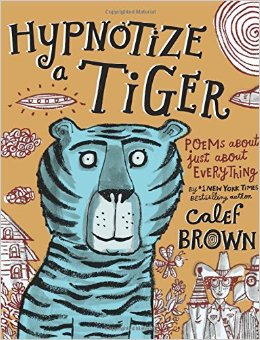 Hypnotize a Tiger: Poems About Just About Everything
Hypnotize a Tiger: Poems About Just About Everything
By Calef Brown
Christy Ottaviano Books, Henry Holt (an imprint of Macmillan)
$17.99
ISBN: 978-0-8050-9928-7
For ages 9-12
Why do I do this to myself? Let me tell you something about how I review. Board books? Pshaw. I can take one and write a nine-paragraph review parsing precisely why it is that Bizzy Bear’s preferred companions are dogs and bunnies. Nonfiction? Lay it on me. I’ll take infinite pleasure in discussing the difference between informational texts when I was a child (long story short, they sucked) and our current golden age. But there is one book genre that lays me flat. Stops me short. Makes it exceedingly difficult for me to get my head in order. Truly, children’s poetry books are the hardest to review. I don’t know exactly why this is. They are the most unloved of the books for kids. No American Library Association accredited awards are made specifically for them. They get checked out of libraries one month a year (April = National Poetry Month) and then lie forgotten. Yet so many of them are bite-sized wallops of greatness. Hypnotize a Tiger by Calef Brown is one of these chosen few. Not many poetry books for kids sport blurbs from Daniel Pinkwater (who found a soul mate in Brown’s art) to Jack Gantos to The Book of Life director Jorge R. Gutierrez. And few author/illustrators are allowed to go as positively wacky and wild as Brown does here. From tomato ultimatums and loofah tortes to velocipede odes and dodgebull (rather than dodgeball) you honestly never know where the book is going next. And you’re grateful for it.
So if it’s so great (and it is) why is reviewing a book of this sort the devil to do? There are any number of reasons. When reviewing a book with, say, a plot, it’s awfully easy for me to merely recap the plot, dish on the characters, bring up some single strange or scintillating point, then close it all down with a conclusion. Easy peasy. But poetry’s not really like that. There’s no plot to Hypnotize a Tiger. There’s not even a running gag that keeps cropping up throughout the pages. Each poem is its own little world. As a result, I’m stuck generalizing about the poems as a whole. And because we are dealing with 84-85 (depending on how you count) of them in total, I’m probably going to end up saying something about how some of the poems work and others don’t. This is kind of a cheat when you’re reviewing a collection of this sort because almost no children’s poetry book is absolutely perfect (Example A: The fact that Shel Silverstein wrote “Hug-a-War” . . . I rest my case). They will always consist of some verses that work and others that do not. In the end, the best I can hope for when reviewing poetry is to try to find something that makes it different from all the other poetry books published in a given year. Fortunately for me, Mr. Brown is consistently interesting. As Pinkwater said in his blurb, “He is a bulwark against mediocrity.”
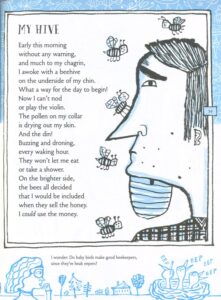 I’m very interested in the question of how to get kids around to reading poetry. My own daughter is four at this time and we’ve found that Shel Silverstein’s poetry books make for good bedtime reading (though she’s still thrown off by the occasional grotesquerie). For many children, Silverstein is the gateway drug. But Calef Brown, though he swims in Shel’s surrealism soaked seas, is a different breed entirely from his predecessor. Where Shel went for the easy silly ideas, Brown layers his ridiculousness with a bit of sophistication. Anyone could write a poem about waking up to find a beehive attached to the underside of their chin. It takes a Calef Brown to go one step further and have the unfortunate soul consider the monetary implications. Or to consider the verbal capabilities of Hoboken-based gnomes. So Hypnotize a Tiger becomes a book meant for the kid with a bit of prior poetry knowledge under their belt. You wouldn’t hand this title to a reluctant reader. You’d give it to the kid who’d already devoured all the Silverstein and Prelutsky and came to you asking, “What else you got?” That kid might be ready.
I’m very interested in the question of how to get kids around to reading poetry. My own daughter is four at this time and we’ve found that Shel Silverstein’s poetry books make for good bedtime reading (though she’s still thrown off by the occasional grotesquerie). For many children, Silverstein is the gateway drug. But Calef Brown, though he swims in Shel’s surrealism soaked seas, is a different breed entirely from his predecessor. Where Shel went for the easy silly ideas, Brown layers his ridiculousness with a bit of sophistication. Anyone could write a poem about waking up to find a beehive attached to the underside of their chin. It takes a Calef Brown to go one step further and have the unfortunate soul consider the monetary implications. Or to consider the verbal capabilities of Hoboken-based gnomes. So Hypnotize a Tiger becomes a book meant for the kid with a bit of prior poetry knowledge under their belt. You wouldn’t hand this title to a reluctant reader. You’d give it to the kid who’d already devoured all the Silverstein and Prelutsky and came to you asking, “What else you got?” That kid might be ready.
It is useful to note that you need to read this book aloud as well. There should be a warning sticker on the cover that says as much. Not that Brown makes it easy for you. Take the poem “Hugh”, for example. Short and simple it reads, “Meet my Belgian friend / He lives near Bruges, on a farm. / His name is Hugh Jarm.” Then at the bottom one of the tiny interstitial poems reads, “I once had a dream I was visiting Bruges – / snacking on chocolates while riding a luge.” Now the correct pronunciation of “Bruges” isn’t really necessary in the first poem, though it helps. The little tiny poem, however, is interesting because while it works especially well when you pronounce it correctly, you could probably mangle the wordplay easy peasy and still end up with a successful poem. SLJ probably said it best when they mentioned in their review of the book that, “Though there is more than one line that does not roll easily off the tongue and awkward rhymes abound, it is easy to see this clumsiness as part of the spirit of the collection.”
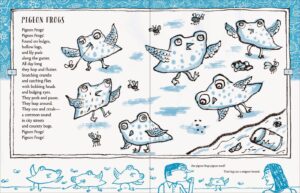 The subtitle of the collection is “Poems About Just About Everything” and that’s a fairly accurate representation. It does not mean, however, that there isn’t an internal logic to what’s being included here. There’s a chapter of animal poems, of people, insects, vehicles, schools, food, and then more esoteric descriptions like “Facts Poetic”, “Word Crashes”, and “Miscellaneous Silliness.” No poem directly applies to another, but they still manage to work together in tandem fairly well.
The subtitle of the collection is “Poems About Just About Everything” and that’s a fairly accurate representation. It does not mean, however, that there isn’t an internal logic to what’s being included here. There’s a chapter of animal poems, of people, insects, vehicles, schools, food, and then more esoteric descriptions like “Facts Poetic”, “Word Crashes”, and “Miscellaneous Silliness.” No poem directly applies to another, but they still manage to work together in tandem fairly well.
I don’t think it’s a serious criticism of a book to say that it’s not for all audiences. Calef Brown is an acquired taste. A taste best suited to the cleverest of the youngsters, absolutely, but acquired just the same. Not everyone is drawn to his style, and more fool they. To my mind, there is room enough in this world for any Calef Brown collection you can name. This book doesn’t have the widely popular feel of, say, a We Go Together but nor is the author writing poems simply to hear himself speak. Hypnotize a Tiger is a book built to please fans of creative curated silliness. Don’t know if you’ll like it? There’s only one way to find out. Pick this puppy up and read it to a kid. The book may surprise you (and so might the kid!).
On shelves now.
Source: Final copy sent from publisher for review.
Like This? Then Try:
Misc:
- I think this may honestly constitute the greatest class visit of all time.


By:
Betsy Bird,
on 4/15/2015
Blog:
A Fuse #8 Production
(
Login to Add to MyJacketFlap)
JacketFlap tags:
Reviews,
poetry,
Best Books,
funny poetry,
Enchanted Lion Books,
Joohee Yoon,
collected poetry,
Best Books of 2015,
Reviews 2015,
2015 reviews,
2016 Caldecott contenders,
2015 poetry,
Add a tag
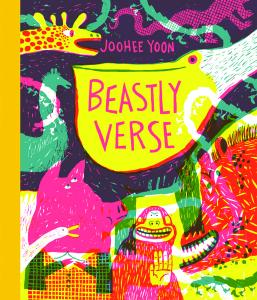 Beastly Verse
Beastly Verse
By Joohee Yoon
Enchanted Lion Books
$18.95
ISBN: 978-1-59270-166-7
Ages 3 and up
On shelves now
Poetry. What’s the point? I say this as a woman who simultaneously gets poetry and doesn’t get it. I get that it’s important, of course. I only need to watch my three-year-old daughter come up with an ever increasing and creative series of bouncy rhymes to understand their use. But what I don’t get is Poetry with a capital “P”. I have come to accept this as a failing on my own part. And to be fair, there are works of poetry that I like. They just all seem to be for the milk teeth set. With that in mind I was particularly pleased to see Beastly Verse, illustrated by Joohee Yoon. Full of fabulous classic poems and art that manages to combined a distinctive color palette with eye-popping art, Yoon’s creates a world that takes the madcap energy of Dr. Seuss and combines it with the classic printmaking techniques of a fine artist. The end result keeps child readers on the edge of their seats with adults peering over their shoulders, hungry for more.
As I mentioned, the resident three-year-old is much enamored of poetry. This is good because it makes her an apt test subject for my own curiosity. I should mention that my goal in life is to NOT become the blogger who uses her children to determine the value of one book or another. That said, the temptation to plumb their little minds can sometimes prove irresistible. Now Beastly Verse is not specifically aimed at the preschooler set. With poems like William Blake’s “The Tiger” and “Humming-Bird” by D.H. Lawrence, the verse can at times exceed a young child’s grasp. That said, none of the poems collected here are very long, and the art is so entrancing that the normal fidgets just tend to fade away as you turn the pages. My daughter did find that some of the more frightening images, say of the carnivorous hummingbird or the spangled pandemonium, were enough to put her off. Fortunately, each scary image is hidden beneath a clever gatefold. If the reader does not want to see the face of a tiger tiger burning bright, they needn’t open the fold at all. Not only is it a beautiful technique, it makes the book appropriate for all ages. Clever.
 One might not associate Yoon’s particular brand of yellows reds, oranges, greens, and blues with evocative prints. Yet time and again I was struck by the entrancing beauty of the pages. Yoon’s traditional printmaking techniques can bring to life the hot steam that rises even in the coolest shade of a tiger’s jungle. Another page and Lewis Carroll’s “The Crocodile” lingers below the surface of the water, his innards heaving with “little fishes”. Yoon saves the best for last, though, with a poem I’d not come across before. “Dream Song” by Walter de la Mare is set in the gleam of “Sunlight, moonlight / Twilight, starlight” when the sun is just a sliver of a white hot crescent on the horizon. All the forest is lit by the orange and red rays, and out of a tree pokes the head of a single owl. The hypnotic verses speaking of “wild waste places far away” mix with the image, conjuring up the moment moviemakers call “magic hour”.
One might not associate Yoon’s particular brand of yellows reds, oranges, greens, and blues with evocative prints. Yet time and again I was struck by the entrancing beauty of the pages. Yoon’s traditional printmaking techniques can bring to life the hot steam that rises even in the coolest shade of a tiger’s jungle. Another page and Lewis Carroll’s “The Crocodile” lingers below the surface of the water, his innards heaving with “little fishes”. Yoon saves the best for last, though, with a poem I’d not come across before. “Dream Song” by Walter de la Mare is set in the gleam of “Sunlight, moonlight / Twilight, starlight” when the sun is just a sliver of a white hot crescent on the horizon. All the forest is lit by the orange and red rays, and out of a tree pokes the head of a single owl. The hypnotic verses speaking of “wild waste places far away” mix with the image, conjuring up the moment moviemakers call “magic hour”.
Mind you, there is always a nightmarish mirror image to each seemingly sweet picture. The eyeless caterpillar all maw and teeth is turned, on the next page, into a beautiful but equally unnerving butterfly. Only Yoon, as far as I’m concerned, could have brought us the horrific implications of “The Humming-Bird” and its existence “Before anything had a soul.” Even the last seemingly innocuous image of Captain Jonathan cooking himself an egg takes on a dire cast when you realize it’s that of a pelican (of the poem “The Pelican” by Robert Desnos) he’s about to devour.
 This is by no means the first collection of animal poetry to grace our shelves. It was only two or three years ago that J. Patrick Lewis helped to collect the National Geographic Book of Animal Poetry. Many of the poems found in this book can be found in that one as well. However, while that book seemed to be going for sheer girth, Yoon’s selections here are carefully positioned. I was interested in the layout in particular. You begin with the aforementioned Carroll poem (which seems appropriate since a manic smiling cat graces the title page) and then transition into a nursery rhyme, a bit of typical Ogden Nash flippery (only three lines long), and then Blake’s best-known poem. Variety of length keeps the poems eclectic and interesting to read. They keep you guessing as well. You never quite know what kind of poem will come next.
This is by no means the first collection of animal poetry to grace our shelves. It was only two or three years ago that J. Patrick Lewis helped to collect the National Geographic Book of Animal Poetry. Many of the poems found in this book can be found in that one as well. However, while that book seemed to be going for sheer girth, Yoon’s selections here are carefully positioned. I was interested in the layout in particular. You begin with the aforementioned Carroll poem (which seems appropriate since a manic smiling cat graces the title page) and then transition into a nursery rhyme, a bit of typical Ogden Nash flippery (only three lines long), and then Blake’s best-known poem. Variety of length keeps the poems eclectic and interesting to read. They keep you guessing as well. You never quite know what kind of poem will come next.
Having read the deliciously multicultural Over the Hills and Far Away, collected by Elizabeth Hammill, it is difficult to pick up a collected work of poetry without hankering for a similar experience. Aside from artist Joohee Yoon’s own name and the fact that Robert Desnos was Jewish, there is very little in this collection that isn’t white and American/European. The reasons for this may have something to do with permissions. Every poem in this book, with the exception of a few, is in the public domain. None were commissioned for the book specifically. Mind you, it would have been possible for the book to follow Hammill’s lead and locate international public domain animal poems of one sort or another written specifically for children. It is therefore up to the reading public to ascertain if the book stands stronger as a collection of similar types of poetry or if it would have benefited from a bit of variety here and there.
In the end, it’s a beautiful piece. Children’s rooms are no strangers to beautiful art in their poetry collections, but Yoon’s distinctive style is hard to compare to anyone. The only poet/illustrator with the same energy that comes to mind (and that writes for kids) would have to be Calef Brown. And as debuts go, this is a stunner. A truly inventive and original collection that deepens with every additional read. Kids like it. Adults like it. It could have benefited from some diversity, absolutely. Overall, however, there are few things like it on our shelves. An inspiration.
On shelves now.
Source: Final copy sent from publisher for review.
Like This? Then Try:
Other Blog Reviews: A Year of Reading
Professional Reviews:
Misc: Years ago, it was Jules at Seven Impossible Things who alerted the children’s book world to Ms. Yoon’s presence. Here is the post.

By:
Donna Earnhardt,
on 1/7/2015
Blog:
WORDS
(
Login to Add to MyJacketFlap)
JacketFlap tags:
fun,
poetry,
school,
students,
poems,
writing for children,
fun poems,
january,
funny poetry,
student poetry,
Add a tag
I love January, but my sweet homeschool kiddos don’t seem to love it quite as much. Thus, a blues poem for my girls and all the students who wish they were still on Christmas vacation… School is in session Equations are flying Students are moaning Brain cells are frying Reading and painting Dividing and…
By:
Donna Earnhardt,
on 9/9/2014
Blog:
WORDS
(
Login to Add to MyJacketFlap)
JacketFlap tags:
fun poetry,
kids poetry,
funny poetry,
kids poems,
Kenn Nesbitt,
weirdos,
unexpected,
kidlit,
halloween,
kids,
fun,
poetry,
autumn,
fall,
weird,
poems,
writing for children,
shadow,
vegetarian,
werewolf,
moonlight,
Add a tag
Inspired by Kenn Nesbitt’s, “My Brother’s not a Werewolf”. Hope you enjoy. Tale of the WeirdoWolfBy Donna Earnhardt He transformed in the daytimeavoiding moonlit nightsHe cringed at his own shadow,fear brought him no delight He was a vegetarian.He loved to draw and paint.And when he howled,No one was cowed*,Except for him… He’d faint. …

By:
Betsy Bird,
on 1/31/2013
Blog:
A Fuse #8 Production
(
Login to Add to MyJacketFlap)
JacketFlap tags:
Reviews,
poetry,
Jack Prelutsky,
Harper Collins,
Best Books,
Greenwillow,
Carin Berger,
funny picture books,
funny poetry,
picture book poetry,
Best Books of 2013,
Reviews 2013,
2014 Caldecott Contender,
2013 funny books,
2013 poetry,
Add a tag
 Stardines Swim High Across the Sky and Other Poems
Stardines Swim High Across the Sky and Other Poems
By Jack Prelutsky
Illustrated by Carin Berger
Greenwillow Books (an imprint of Harper Collins)
$16.99
ISBN: 978-0-06-201464-1
Ages 4-8
On shelves February 26th.
To non-children’s librarians the statistics are baffling. Your average poetry book isn’t exactly a circ buster. It sits on the shelf for months at a time, gathering dust, biding its time. When kids come to the reference desk to ask for titles, they don’t tend to ask for poetry unless they’ve some sort of assignment they need to fulfill. Yet for all that poetry books for kids are shelf sitters, it’s hard to find a single one that hasn’t gone out in the last two or three months. How to account for it? Well, there’s Poetry Month (April) to begin with. That always leads to a run on the 811 portion of the library shelves. But beyond that kids read poetry in dribs and drabs over the course of the year. Maybe as Summer Reading books. Maybe as class assignments. Whatever the reason, poetry has a longevity, if not a popularity, that’s enviable. Now Jack Prelutsky, our first Children’s Poet Laureate and creator of Behold the Bold Umbrellaphant is following up his work with yet another delve into (in the words of Kirkus) “iambic ‘pun’tameter”. And while Prelutsky gives us a second round, illustrator Carin Berger steps up her game to give these hybrid birds and beasts a kick in the old artistic derriere.
 Forget everything you ever knew about animals. Not since On Beyond Zebra has the world seen a menagerie quite as wild as the one on display here. Step right up, folks, and take a gander at the rare and remarkable Fountain Lion. “The only lions no one dreads, / They all have fountains on their heads.” Delicious crustaceans more your speed? Then come and observe the rare Slobsters. “Their sense of decorum / Is woefully small. / Slobsters don’t have / Many manners at all.” Or for the kiddies, how about an adorable Planda? “They plan to learn to roller-skate, / To juggle, and to fence. / They plan to go to clown school / And cavort in circus tents.” With his customary clever verse, Jack Prelutsky invents sixteen imaginary animals of varying degrees of odd. Accompanying his rhymes is his old partner-in-crime Carin Berger, who has moved beyond mere collage and has gone so far to construct elaborate shadow boxes of each and every poem. The end result is impressive, hilarious, and one of the most original little poetry collections you’ll see in many a year.
Forget everything you ever knew about animals. Not since On Beyond Zebra has the world seen a menagerie quite as wild as the one on display here. Step right up, folks, and take a gander at the rare and remarkable Fountain Lion. “The only lions no one dreads, / They all have fountains on their heads.” Delicious crustaceans more your speed? Then come and observe the rare Slobsters. “Their sense of decorum / Is woefully small. / Slobsters don’t have / Many manners at all.” Or for the kiddies, how about an adorable Planda? “They plan to learn to roller-skate, / To juggle, and to fence. / They plan to go to clown school / And cavort in circus tents.” With his customary clever verse, Jack Prelutsky invents sixteen imaginary animals of varying degrees of odd. Accompanying his rhymes is his old partner-in-crime Carin Berger, who has moved beyond mere collage and has gone so far to construct elaborate shadow boxes of each and every poem. The end result is impressive, hilarious, and one of the most original little poetry collections you’ll see in many a year.
The shadow box, that staple of undergraduate art projects everywhere, is a relative newcomer to the world of children’s literature. A shadow box, once you’ve designed it and filled it with cool images, needs to be photographed perfectly if it’s going to work on a flat page. That means you need an illustrator confident in their abilities to produce art that will look as good in two dimensions as three. Berger is clearly up to the challenge. A master of collage, in this book she bends over backwards to make her images the best they can be. She’s very good at conveying distance. She also conveys perspective quite well. A cut image of a bicycle makes it appear to be three-dimensional because it is photographed from above. I know the image itself is just a flat piece of paper, but the illusion is complete. Everything, in fact, appears to have been planned with a meticulous eye.
Even within the boxes themselves Berger’s job is not easy. Consider an early poem called “Bluffaloes” which combines the word “Buffaloes” with the word “Bluff”. It’s about buffalo types who are scaredy cats should you call their bluff. Fair enough. Now how the heck do you illustrate that? In Berger’s case it looks like she may have considered an alternative definition of the word “bluff” as in “a cliff, headland, or hill with a broad, steep face” since her bluffaloes look like nothing so much as little pieces of a cliff running hither and thither on newly sprouted legs. Artistic creativity is much called for when wordplay is open ended.
 Of course, as an adult I’m going to be naturally inclined towards artsy fartsy styles. But this all begs the obvious question: Will kids dig it? Well, let’s stop and consider for a moment. What precisely has Berger done? She has made little boxes and put action-packed scenes within them. Who else does that kind of thing? If you said, “Kids who make dioramas for school” you have earned yourself a cookie. Yes, it appears to me that Berger has taken one of the oldest homework assignments of our age and has turned it into a book. An enterprising teacher would find a goldmine of assignment material here. What if they had their kids write their own poems in Prelutsky’s style? What if they made pairs of kids come up with the idea for the poem and then one kid could write it while the other made a diorama to go with it? Can you now say, “instantaneous original poetry project for Poetry Month”? I knew you could.
Of course, as an adult I’m going to be naturally inclined towards artsy fartsy styles. But this all begs the obvious question: Will kids dig it? Well, let’s stop and consider for a moment. What precisely has Berger done? She has made little boxes and put action-packed scenes within them. Who else does that kind of thing? If you said, “Kids who make dioramas for school” you have earned yourself a cookie. Yes, it appears to me that Berger has taken one of the oldest homework assignments of our age and has turned it into a book. An enterprising teacher would find a goldmine of assignment material here. What if they had their kids write their own poems in Prelutsky’s style? What if they made pairs of kids come up with the idea for the poem and then one kid could write it while the other made a diorama to go with it? Can you now say, “instantaneous original poetry project for Poetry Month”? I knew you could.
Then there’s Prelutsky. He always scans. He always rhymes. And he throws in big words that will give some children a good dictionary workout. For example, in the Sobcat poem he writes, “The SOBCAT is sad / As a feline can be / And spends its time crying / Continuously. / It has no real reason / To be so morose. / It’s simply its nature / To act lachrymose.” Nice. Of course the unspoken secret to many of these poems isn’t that they simply make clever pairings of words and phrases with animals but that they say something about certain types of people. The Planda makes eternal plans and never carries them out. The Sobcat “delights / In its own misery”. You can find many a friend and a relation found in the animals of these pages.
The pairings of the poems is sometimes key. It works particularly well when you place the “Jollyfish” poem next to the “Sobcat”, for example. There are other moments when you suspect that the layout and order of the poems was a carefully thought out process. The book begins, for example, with the titular poem “Stardines” which comments that “In silence, these nocturnal fish / Are set to grant the slightest wish.” That’s a good note to begin on. The book then alternates between animals with physical attributes that are their primary lure and animals with one-of-a-kind personality quirks. It’s interesting to see how all this ends with, of all the animals, the Bardvark. “BARDVARKS think they’re poets / And persist in writing rhyme. / Their words are uninspired / And a total waste of time.” So it is that book of poetry for kids ends by highlighting an animal that’s an atrocious poet. The final lines, “Undeterred, they keep on writing / And reciting every day. / That’s why BARDVARKS are a problem – / You can’t make them go away.” One can’t help but think Prelutsky is taking a little jab at himself here. Not a significant jab, but small enough to allow him to laugh at himself a little. Not a bad way to finish, really.
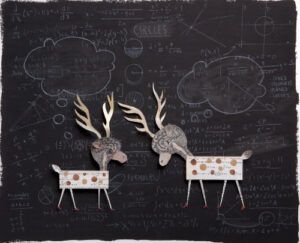 Perhaps a key at the back of the book explaining which animals and concepts were combined would not have been out of place. I found myself baffled by the “swapitis” (pronounced swap-uh-teez) and found myself wishing I knew what animal it hailed from. It looks somewhat deer-like. After a bit of internet searching I discovered an animal called a wapitis, which is a kind of North American deer. Good to know, though I suspect it won’t immediately pop to many folks’ minds unless prompted and prodded a bit. Of course having kids find the animals referenced could be a fun homework assignment in and of itself. There are possibilities there. Just no answers.
Perhaps a key at the back of the book explaining which animals and concepts were combined would not have been out of place. I found myself baffled by the “swapitis” (pronounced swap-uh-teez) and found myself wishing I knew what animal it hailed from. It looks somewhat deer-like. After a bit of internet searching I discovered an animal called a wapitis, which is a kind of North American deer. Good to know, though I suspect it won’t immediately pop to many folks’ minds unless prompted and prodded a bit. Of course having kids find the animals referenced could be a fun homework assignment in and of itself. There are possibilities there. Just no answers.
Jack Prelutsky is a staple. Folks my age still associate him with The New Kid On the Block. Kids these days have a lot more Prelutskyian choices to pick from. Berger, in contrast, is new and fresh and bright and shiny. Combine the old school rhymes and chimes of a Prelutsky with the crackling energy and visual wit of Berger and you’ve got yourself a heckuva team. Stardines may tread familiar ground once trod before, but its method of presentation is anything but overdone. Hand this one to the kid who moans to you that they “have” to read a book of poetry for school. Who knows? It may hook ‘em before they realize what’s what. One of a kind.
On shelves February 26th.
Source: Galley sent from publisher for review.
Like This? Then Try:
- Wabi Sabi by Mark Reibstein, illustrated by Ed Young
Other Blog Reviews: Book Aunt
Professional Reviews:
Misc:
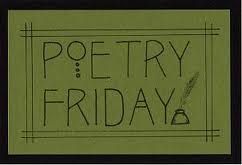 Read this great little short interview with Ms. Berger at Seven Impossible Things Before Breakfast as she discusses how, “This seemed a perfect opportunity to reference my passion for wunderkammers and early science — and crusty old museums.”
Read this great little short interview with Ms. Berger at Seven Impossible Things Before Breakfast as she discusses how, “This seemed a perfect opportunity to reference my passion for wunderkammers and early science — and crusty old museums.”
- It’s Poetry Friday! Head on over to Teaching Authors to see the round-up of other great poetry books of the day!
Video:
Take a studio tour into the world of Carin Berger to see some of the fantastic art from this book.






Wish I wrote it...
Books to the Ceiling
By Arnold Lobel
Books to the ceiling,
books to the sky.
My pile of books are a mile high.
How I love them!
How I need them!
I'll have a long beard
by the time I read them.
 Fun Fact: The American Library Association does not currently give an award specifically to great works of children’s book poetry. Is not that strange? When I first discovered this to be true, I was perplexed. I’ve always been a bit of a rube when it comes to the poetic form. Placing stresses on syllables and knowing what constitutes a sestina and all that. Of course even without its own award specifically, poetry can win the Newbery or the Caldecott. Yet too often when it happens it’s in the form of a verse novel or its sort of pooh-poohed for its win. Remember when Last Stop on Market Street won the Newbery and folks were arguing that it was the first picture book to do so since A Visit to William’s Blake’s Inn couldn’t possibly be considered a picture book because it was poetry? None of this is to say that poetry doesn’t win Newberys (as recently as 2011 Dark Emperor and Other Poems of the Night by Joyce Sidman won an Honor) but aside from the month of April (Poetry Month a.k.a. the only time the 811 section of the public library is sucked dry) poetry doesn’t get a lot of attention.
Fun Fact: The American Library Association does not currently give an award specifically to great works of children’s book poetry. Is not that strange? When I first discovered this to be true, I was perplexed. I’ve always been a bit of a rube when it comes to the poetic form. Placing stresses on syllables and knowing what constitutes a sestina and all that. Of course even without its own award specifically, poetry can win the Newbery or the Caldecott. Yet too often when it happens it’s in the form of a verse novel or its sort of pooh-poohed for its win. Remember when Last Stop on Market Street won the Newbery and folks were arguing that it was the first picture book to do so since A Visit to William’s Blake’s Inn couldn’t possibly be considered a picture book because it was poetry? None of this is to say that poetry doesn’t win Newberys (as recently as 2011 Dark Emperor and Other Poems of the Night by Joyce Sidman won an Honor) but aside from the month of April (Poetry Month a.k.a. the only time the 811 section of the public library is sucked dry) poetry doesn’t get a lot of attention.






























Wonderful list with some titles I have yet to explore. I would have to add Joyce Sidman’s lovely book, Before Morning, and Irene Latham’s whimsical book of poems inspired by the farmer’s market, Fresh Delicious. Loved Wet Cement and When Green Becomes Tomatoes.
I also loved When Green Becomes Tomatoes, Wet Cement & Slickety Quick (as well as Brown’s verse novel, To Stay Alive).
Some other titles I enjoyed: Irene Latham’s When the Sun Shines on Antarctica, David Harrison’s Now You See Them, Now You Don’t and Mirror Mirror by Marilyn Singer.
It is strange that ALA does not give a children’s poetry award, but NCTE does. Many of the above titles are on the latest list plus the Verse Novel List. These titles and all the previous years can be found at: http://www.ncte.org/awards/poetry
I pondered including Before Morning, but figured it slotted better on the upcoming picture book list. Fear not! It has not been forgotten.